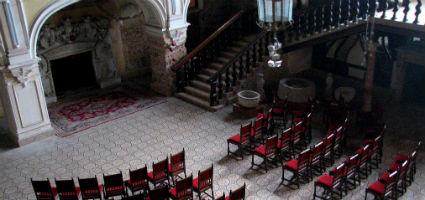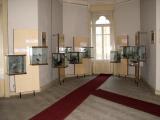2025. July 11. Friday
Town Museum of Nagykároly - Carei
 |
Address: 445100, Carei Piaţa 25 Octombrie nr. 1
Phone number: (261) 864-981
E-mail: nagykarolyi@freemail.hu
Opening hours: Winter: Tue-Fri 9-17, Sat 10-14, Sun 9-17
Summer: Tue-Fri 10-18, Sat 10-14, Sun 10-18 |
In the area almost every museum's collections were based by school activities. This happened in Carei as well. Graff Alexander Károlyi settled a Piarist School in 1727-28 and its equipment store had serious geologic and natural collections with educational purpose.
The new fashion of interest in the old times caused the formation of museum societies in order to collect the historical and folkloric relics and objects of the area. The cultural society from Carei urged the establishment of a county museum in the capital of the county at that time, Carei. An order was voted in the general meeting and the museum was created.
The museum itself opened only in 1903 in a larger room of the county house including 788 articles and quite a rich library of 4076 books. The archeological waifs from the county were placed here. Vende Aladár archeologist provided the museum with rich collections of waifs from Care-Bobald and other areas (Borovszky Samu: The Monography of Satu Mare County, 400.p.). Later, in 1919 fourteen very expensive and valuable paintings came to the museum's property.
Between the two World Wars Satu Mare became the capital of the county. So the collections of the museum and the archives were moved to Satu Mare and the activity of the Museum of Carei ceased.
After the Second World War the enthusiastic teachers of the pedagogical school restarted to collect the archeological and other articles. In 10 June 1958 they settled a new town-museum inside the castle of Graff Károlyi with a natural and a historical section. The second specialized in archeology, because Carei and its surroundings are very rich in archeological waifs. In 1967 the permanent archeological exhibition opened, quickly followed by the natural one.
The archeological researches created such a rich collection that its scientific value is well-known abroad. Our botanical collection has the same value and international significance.
For a while the town museum was responsible for Ady Endre Memorial House from Érmindszent (today Ady Endre). We created two exhibitions and renovated the two buildings for the Ady centenary, 1977.
The staff of Carei Museum has involved in the town's cultural life as well. We organized lots of temporary exhibitions, presenting photo art, fine arts, local history, nature, folklore and handicrafts, 8-10 exhibitions per year.
The town and its surroundings have a lot of sights: the castle of Graff Károlyi, the dendrological park around it, the burying-place of the Károlyi family in a nearby village, Kaplony, the architecture of the town, its cultural and literary traditions. That's why the museum's researchers always accentuated the sightseeing guidance.
Today the museum's archeological, historical collection includes almost 30,000 articles, the natural collection has almost 25,000 objects.
The new fashion of interest in the old times caused the formation of museum societies in order to collect the historical and folkloric relics and objects of the area. The cultural society from Carei urged the establishment of a county museum in the capital of the county at that time, Carei. An order was voted in the general meeting and the museum was created.
The museum itself opened only in 1903 in a larger room of the county house including 788 articles and quite a rich library of 4076 books. The archeological waifs from the county were placed here. Vende Aladár archeologist provided the museum with rich collections of waifs from Care-Bobald and other areas (Borovszky Samu: The Monography of Satu Mare County, 400.p.). Later, in 1919 fourteen very expensive and valuable paintings came to the museum's property.
Between the two World Wars Satu Mare became the capital of the county. So the collections of the museum and the archives were moved to Satu Mare and the activity of the Museum of Carei ceased.
After the Second World War the enthusiastic teachers of the pedagogical school restarted to collect the archeological and other articles. In 10 June 1958 they settled a new town-museum inside the castle of Graff Károlyi with a natural and a historical section. The second specialized in archeology, because Carei and its surroundings are very rich in archeological waifs. In 1967 the permanent archeological exhibition opened, quickly followed by the natural one.
The archeological researches created such a rich collection that its scientific value is well-known abroad. Our botanical collection has the same value and international significance.
For a while the town museum was responsible for Ady Endre Memorial House from Érmindszent (today Ady Endre). We created two exhibitions and renovated the two buildings for the Ady centenary, 1977.
The staff of Carei Museum has involved in the town's cultural life as well. We organized lots of temporary exhibitions, presenting photo art, fine arts, local history, nature, folklore and handicrafts, 8-10 exhibitions per year.
The town and its surroundings have a lot of sights: the castle of Graff Károlyi, the dendrological park around it, the burying-place of the Károlyi family in a nearby village, Kaplony, the architecture of the town, its cultural and literary traditions. That's why the museum's researchers always accentuated the sightseeing guidance.
Today the museum's archeological, historical collection includes almost 30,000 articles, the natural collection has almost 25,000 objects.
